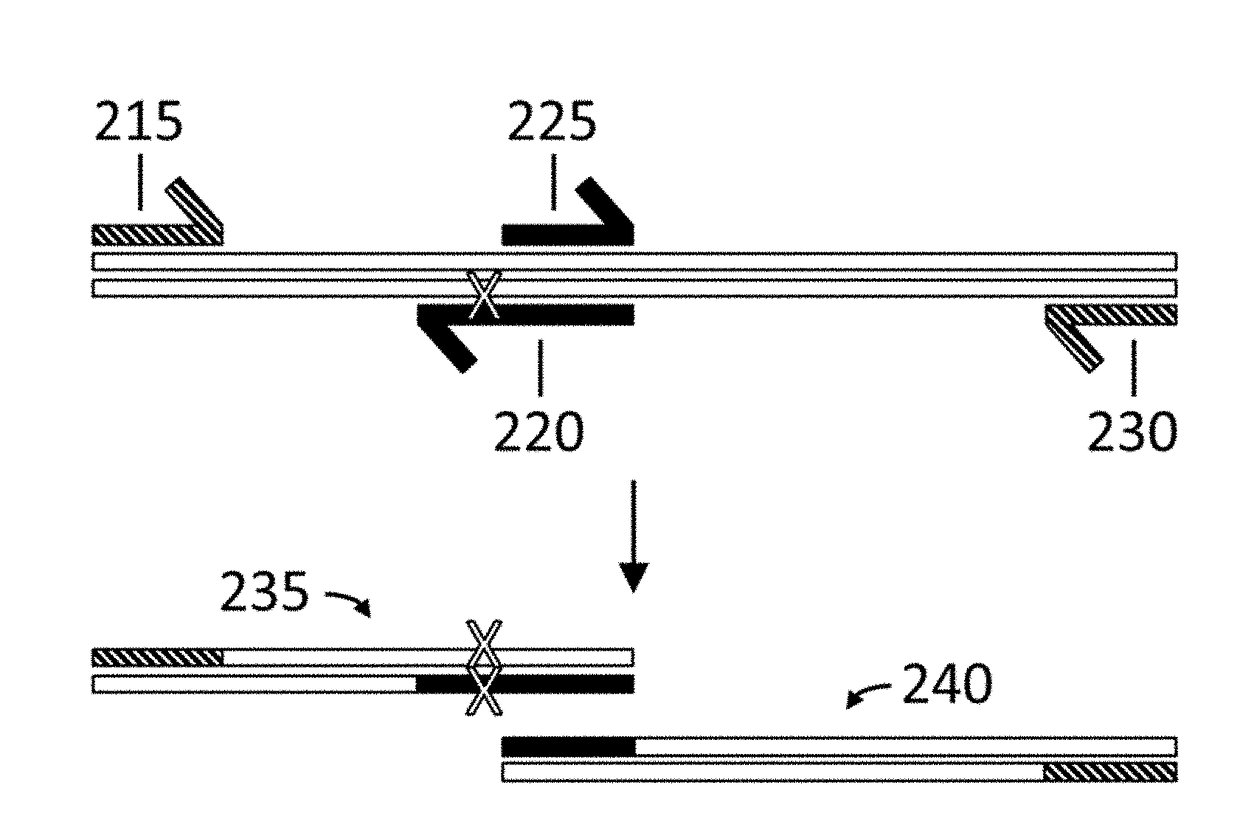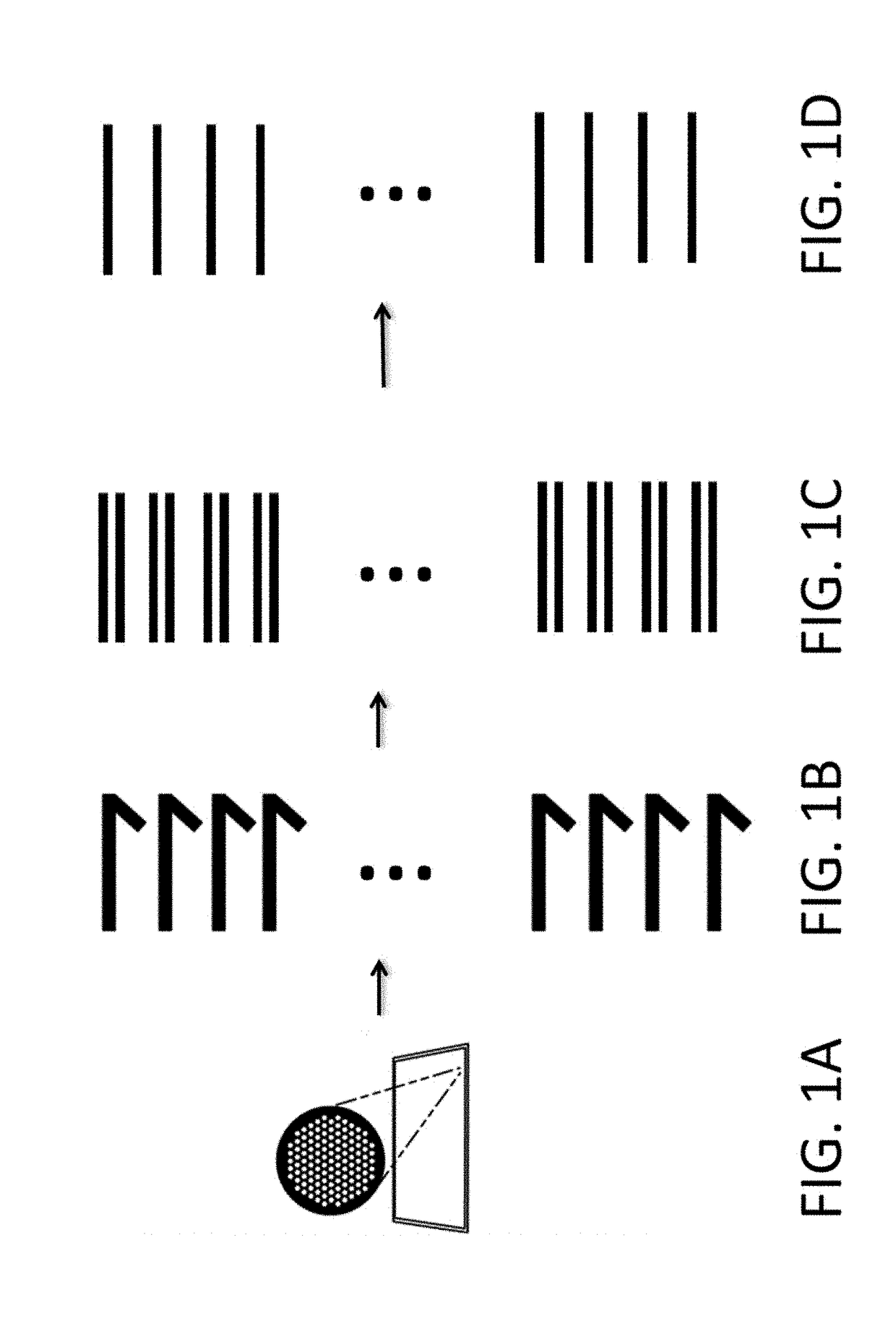Variant libraries of the immunological synapse and synthesis thereof
a technology of immunological synapse and variable libraries, applied in the field of variable libraries of immunological synapse and synthesis thereof, can solve the problems of extending the development time, affecting the speed at which this cycle progresses, and inability to sufficiently explore the sequence space, etc., and achieves the effects of increasing specificity, avidity, stability or expression
- Summary
- Abstract
- Description
- Claims
- Application Information
AI Technical Summary
Benefits of technology
Problems solved by technology
Method used
Image
Examples
example 1
lization of a Device Surface
[0188]A device was functionalized to support the attachment and synthesis of a library of nucleic acids. The device surface was first wet cleaned using a piranha solution comprising 90% H2SO4 and 10% H2O2 for 20 minutes. The device was rinsed in several beakers with DI water, held under a DI water gooseneck faucet for 5 min, and dried with N2. The device was subsequently soaked in NH4OH (1:100; 3 mL:300 mL) for 5 min, rinsed with DI water using a handgun, soaked in three successive beakers with DI water for 1 min each, and then rinsed again with DI water using the handgun. The device was then plasma cleaned by exposing the device surface to O2. A SAMCO PC-300 instrument was used to plasma etch O2 at 250 watts for 1 min in downstream mode.
[0189]The cleaned device surface was actively functionalized with a solution comprising N-(3-triethoxysilylpropyl)-4-hydroxybutyramide using a YES-1224P vapor deposition oven system with the following parameters: 0.5 to 1...
example 2
of a 50-Mer Sequence on a Polynucleotide Synthesis Device
[0191]A two dimensional polynucleotide synthesis device was assembled into a flowcell, which was connected to a flowcell (Applied Biosystems (ABI394 DNA Synthesizer”). The two-dimensional polynucleotide synthesis device was uniformly functionalized with N-(3-TRIETHOXYSILYLPROPYL)-4-HYDROXYBUTYRAMIDE (Gelest) was used to synthesize an exemplary polynucleotide of 50 bp (“50-mer polynucleotide”) using polynucleotide synthesis methods described herein.
[0192]The sequence of the 50-mer was as described in SEQ ID NO.: 20. 5′AGACAATCAACCATTTGGGGTGGACAGCCTTGACCTCTAGACTTCGGCAT##TTTTTTT TTT3′ (SEQ ID NO.: 20), where # denotes Thymidine-succinyl hexamide CED phosphoramidite (CLP-2244 from ChemGenes), which is a cleavable linker enabling the release of oligos from the surface during deprotection.
[0193]The synthesis was done using standard DNA synthesis chemistry (coupling, capping, oxidation, and deblocking) according to the protocol in Ta...
example 3
of a 100-Mer Sequence on a Polynucleotide Synthesis Device
[0197]The same process as described in Example 2 for the synthesis of the 50-mer sequence was used for the synthesis of a 100-mer polynucleotide (“100-mer polynucleotide”; 5′ CGGGATCCTTATCGTCATCGTCGTACAGATCCCGACCCATTTGCTGTCCACCAGTCATG CTAGCCATACCATGATGATGATGATGATGAGAACCCCGCAT##TTTTTTTTTT3′, where # denotes Thymidine-succinyl hexamide CED phosphoramidite (CLP-2244 from ChemGenes); SEQ ID NO.: 21) on two different silicon chips, the first one uniformly functionalized with N-(3-TRIETHOXYSILYLPROPYL)-4-HYDROXYBUTYRAMIDE and the second one functionalized with 5 / 95 mix of 11-acetoxyundecyltriethoxysilane and n-decyltriethoxysilane, and the nucleic acids extracted from the surface were analyzed on a BioAnalyzer instrument (data not shown).
[0198]All ten samples from the two chips were further PCR amplified using a forward (5′ATGCGGGGTTCTCATCATC3′; SEQ ID NO.: 22) and a reverse (5′CGGGATCCTTATCGTCATCG3′; SEQ ID NO.: 23) primer in a 50...
PUM
| Property | Measurement | Unit |
|---|---|---|
| distance | aaaaa | aaaaa |
| distance | aaaaa | aaaaa |
| distance | aaaaa | aaaaa |
Abstract
Description
Claims
Application Information
 Login to View More
Login to View More - R&D
- Intellectual Property
- Life Sciences
- Materials
- Tech Scout
- Unparalleled Data Quality
- Higher Quality Content
- 60% Fewer Hallucinations
Browse by: Latest US Patents, China's latest patents, Technical Efficacy Thesaurus, Application Domain, Technology Topic, Popular Technical Reports.
© 2025 PatSnap. All rights reserved.Legal|Privacy policy|Modern Slavery Act Transparency Statement|Sitemap|About US| Contact US: help@patsnap.com



